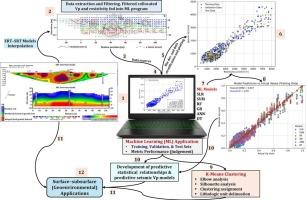机器学习驱动的速度电阻率建模:近地表表征的一种新的显式框架
IF 2.1
3区 地球科学
Q2 GEOSCIENCES, MULTIDISCIPLINARY
引用次数: 0
摘要
机器学习(ML)在地球物理调查中的集成已经成为解决近地表复杂性的关键,特别是在具有复杂岩性非均质性的地形中。本研究旨在开发和验证一种新的机器学习驱动框架,用于联合模拟地震纵波速度(Vp)和电阻率关系,以改善热带花岗岩地形的地下特征。该方法利用来自马来西亚南槟城的地震折射层析成像(SRT)和电阻率层析成像(ERT)调查的数据,通过应用基于轮廓的网格插值来生成密集对齐的数据集,从而解决了传统的集成挑战,减少了人工偏差,将数据量增加了五倍,并增强了非线性预测性能。分层分组确保了在训练、验证和测试集之间平衡的岩性表示。6个ML模型——简单线性回归(SLR)、支持向量机(SVM)、决策树(DT)、随机森林(RF)、梯度增强(GB)和人工神经网络(ANN)——被训练来从电阻率预测Vp。所有模型均具有较高的预测信度(R2 = 0.819-0.984, RMSE = 0.029-0.09, F1 = 0.878-0.910),优于研究区域以往基于回归的方法。人工神经网络的性能最好,其次是支持向量机,两者都保持了所有分区的稳定性。该框架将k-means聚类与内部验证和ml预测的vp -电阻率剖面相结合,自动将岩性分类为四个不同的地下单元。这种综合方法提高了地球物理边界分辨率,保持了快速地质过渡区域的结构保真度,并能够在SRT覆盖范围通常受限的热带风化地形中进行可扩展部署。最终,它将地球物理现场建模从确定性推进到数据驱动的预测,为地质复杂环境中的岩土、水文地质和灾害相关应用提供经济有效、可转移的解决方案。本文章由计算机程序翻译,如有差异,请以英文原文为准。

Machine learning-driven velocity–resistivity modeling: A novel explicit framework for near-surface characterization
The integration of machine learning (ML) in geophysical investigations has become pivotal for resolving near-surface complexities, particularly in terrains with complex lithological heterogeneity. This study aims to develop and validate a novel ML-driven framework for jointly modeling seismic P-wave velocity (Vp) and resistivity relationships to improve subsurface characterization in tropical granitic terrains. Using collocated data from seismic refraction tomography (SRT) and electrical resistivity tomography (ERT) surveys across the South Penang Pluton, Malaysia, the method addresses traditional integration challenges by applying contour-based mesh interpolation to generate a densely aligned dataset—reducing manual bias, increasing data volume fivefold, and enhancing nonlinear predictive performance. Stratified binning ensured balanced lithological representation across training, validation, and test sets. Six ML models—simple linear regression (SLR), support vector machine (SVM), decision tree (DT), random forest (RF), gradient boost (GB), and artificial neural network (ANN)—were trained to predict Vp from resistivity. All models showed high predictive reliability (R2 = 0.819–0.984, RMSE = 0.029–0.09, F1 = 0.878–0.910), outperforming previous regression-based approaches in the study area. ANN achieved the best performance, followed by SVM, both maintaining stability across all partitions. The framework integrates k-means clustering with internal validation and ML-predicted Vp–resistivity profiles to automate lithological classification into four distinct subsurface units. This integrated approach improves geophysical boundary resolution, preserves structural fidelity in zones of rapid geological transition, and enables scalable deployment in tropical weathered terrains where SRT coverage is often constrained. Ultimately, it advances geophysical site modeling from deterministic to data-driven prediction, offering cost-effective, transferable solutions for geotechnical, hydrogeological, and hazard-related applications in geologically complex settings.
求助全文
通过发布文献求助,成功后即可免费获取论文全文。
去求助
来源期刊

Journal of Applied Geophysics
地学-地球科学综合
CiteScore
3.60
自引率
10.00%
发文量
274
审稿时长
4 months
期刊介绍:
The Journal of Applied Geophysics with its key objective of responding to pertinent and timely needs, places particular emphasis on methodological developments and innovative applications of geophysical techniques for addressing environmental, engineering, and hydrological problems. Related topical research in exploration geophysics and in soil and rock physics is also covered by the Journal of Applied Geophysics.
 求助内容:
求助内容: 应助结果提醒方式:
应助结果提醒方式:


